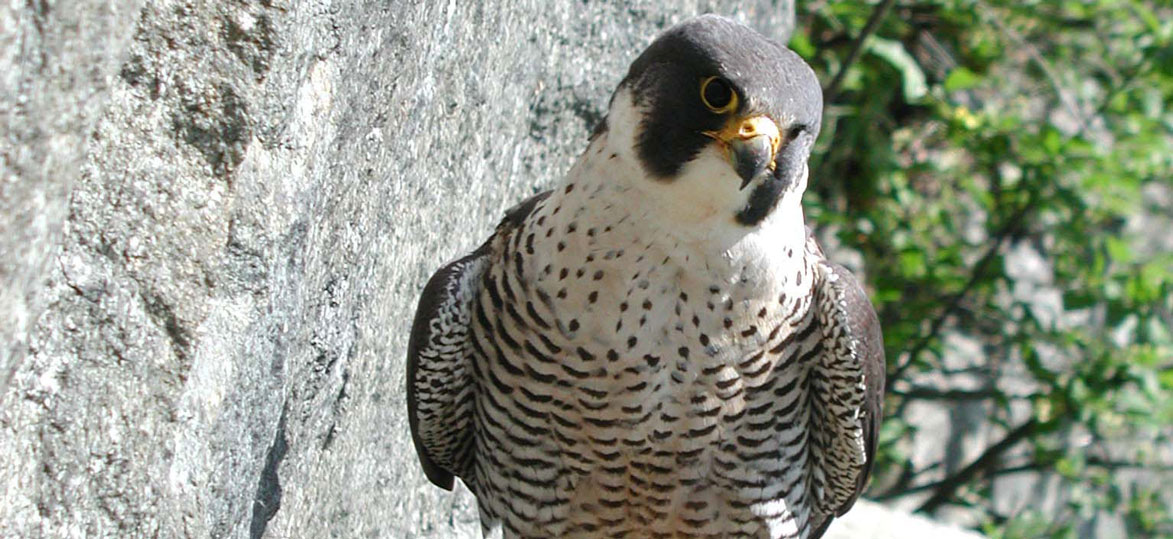
Also known as the "duck-hawk" or the "wanderer," the Peregrine Falcon (Falco peregrinus) is a bird of amazing speed and maneuverability. One of the world's swiftest flyers, this bird of prey has made a remarkable recovery from the effects of DDT. Due to the use of this chemical, all the U.S. peregrines east of the Mississippi River were eliminated.
Efforts to reintroduce peregrines have been successful. In Vermont, relatively high peregrine productivity levels have been sustained since 1991.
Due to the sensitivity of these birds to disturbance, people are cautioned to avoid nesting areas during this period.
Habitat
Peregrine Falcons prefer to nest on high ledges (called eyries) near open areas where they hunt, such as rivers, lakes, and fields. The nest is a section of gravel, sand, or loose soil that has been hollowed out. No additional building materials are brought to the site. The female may lay three to four cream colored eggs, heavily marked with browns.
In winter, most Vermont peregrines migrate south. Some may travel as far as the West Indies, Panama, and Mexico, but most are likely to stay in the U.S.
Reproduction
Peregrine Falcons are cliff nesters, where they choose a ledge that is typically around a third of the way down the cliff face. They also nest on electricity transmission towers, silos, tall buildings, and bridges. They have one brood a year with two to five eggs.
Diet
The primary food is other birds which are most often caught in the air.
Management
The Peregrine Falcon population concerns many people and organizations, including the U.S. Fish and Wildlife Service, National Wildlife Federation, Vermont Institute of Natural Science (VINS), Green Mountain National Forest, The Nature Conservancy, and the Vermont Fish & Wildlife Department.
Efforts to Assist Peregrines
- In 1975, the Peregrine Fund, Inc. led the effort to reintroduce the Peregrine Falcon into Vermont. From 1982 to 1987, young peregrines, born in captivity, were placed in artificial nest boxes and released off a ledge, a process called "hacking."
- Nesting areas are monitored so that the status of nest sites and the number of young raised can be documented.
- Leg bands are placed on chicks to assist long-term tracking efforts of peregrines throughout their range.
- Warning signs are used, and hiking trails may be closed to minimize disturbances during nesting.
Vermont Peregrine Recovery Plan
What You Can Do
- Avoid activities within 1/4 mile of nest sites and especially activities above nests during the breeding season (March-July). Honor warning signs when posted. View cliff closures to protect nesting sites.
- Maintain a respectful distance from wild animals. (Travel with binoculars!) If a bird vocalizes when you're near its territory, immediately back off.
- Observe and report on peregrine sightings and nesting activities in your area.
- Donate any amount to the Nongame Wildlife Fund on your Vermont income tax form, while purchasing a hunting and fishing license, or by direct donation.
Status
Species of Special Concern, Delisted in 2005
Reasons for Decline
- DDT was used as an insecticide until banned in the U.S. in the early 1970s. It widely dispersed throughout the environment where it takes years to break down.
- Peregrines picked up the chemical from the birds they ate. The result was thinner eggshells and a reduced chance of survival for the young. Since the ban of DDT, eggshells are thicker and more young have hatched.
- Other reasons for the decline of Peregrine Falcons include disturbances at nest sites such as predation, human presence, and egg collection.
More Resources
Bird Survey Results - Peregrine Falcon - Nesting success information from monitoring efforts.
